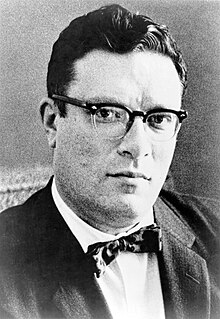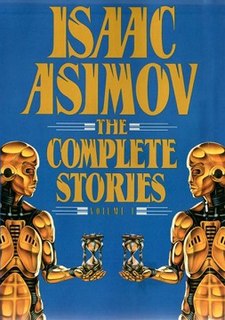Related Research Articles

Isaac Asimov was an American writer and professor of biochemistry at Boston University. He was known for his works of science fiction and popular science. Asimov was a prolific writer who wrote or edited more than 500 books and an estimated 90,000 letters and postcards. His books have been published in 9 of the 10 major categories of the Dewey Decimal Classification.

"The Last Question" is a science fiction short story by American writer Isaac Asimov. It first appeared in the November 1956 issue of Science Fiction Quarterly and was anthologized in the collections Nine Tomorrows (1959), The Best of Isaac Asimov (1973), Robot Dreams (1986), The Best Science Fiction of Isaac Asimov (1986), the retrospective Opus 100 (1969), and in Isaac Asimov: The Complete Stories, Vol. 1 (1990). It was Asimov's favorite short story of his own authorship, and is one of a loosely connected series of stories concerning a fictional computer called Multivac. The story overlaps science fiction, theology, and philosophy.

"Nightfall" is a 1941 science fiction novelette by American writer Isaac Asimov about the coming of darkness to the people of a planet ordinarily illuminated by sunlight at all times. It was adapted into a novel with Robert Silverberg in 1990. The short story has been included in 48 anthologies, and has appeared in six collections of Asimov's stories. In 1968, the Science Fiction Writers of America voted "Nightfall" the best science fiction short story written prior to the 1965 establishment of the Nebula Awards, and included it in The Science Fiction Hall of Fame Volume One, 1929-1964.

"Sally" is a science fiction short story by Isaac Asimov. It was first published in the May–June 1953 issue of Fantastic and later appeared in the Asimov collections Nightfall and Other Stories (1969) and The Complete Robot (1982).

Nightfall and Other Stories (1969) is an anthology book compiling 20 previously published science fiction short stories by Isaac Asimov. Asimov added a brief introduction to each story, explaining some aspect of the story's history and/or how it came to be written.

"C-Chute" is a science fiction short story by American writer Isaac Asimov. It was first published in the October 1951 issue of Galaxy Magazine and later appeared in Asimov's collections Nightfall and Other Stories (1969) and The Best of Isaac Asimov (1973).
The first Golden Age of Science Fiction, often recognized in the United States as the period from 1938 to 1946, was an era during which the science fiction genre gained wide public attention and many classic science fiction stories were published. In the history of science fiction, the Golden Age follows the "pulp era" of the 1920s and 1930s, and precedes New Wave science fiction of the 1960s and 1970s. The 1950s are a transitional period in this scheme; however, Robert Silverberg, who came of age in the 1950s, saw that decade as the true Golden Age.
"Segregationist" is a science fiction short story by American writer Isaac Asimov. The story was written in April 1967 and was first published in December in Abbottempo, a magazine produced by Abbott Laboratories, then later included in the collections Nightfall and Other Stories (1969), The Complete Robot (1982) and Robot Visions (1990).

The Complete Stories is a discontinued series intended to form a definitive collection of Isaac Asimov's short stories. Originally published in 1990 and 1992 by Doubleday, it was discontinued after the second book of the planned series. Altogether 86 of Asimov's 383 published short stories are collected in these two volumes.
"The Machine That Won the War" is a science fiction short story by American writer Isaac Asimov. The story first appeared in the October 1961 issue of The Magazine of Fantasy & Science Fiction, and was reprinted in the collections Nightfall and Other Stories (1969) and Robot Dreams (1986). It was also printed in a contemporary edition of Reader's Digest, illustrated. It is one of a loosely connected series of such stories concerning a fictional computer called Multivac.
"Strikebreaker" is a science fiction short story by American writer Isaac Asimov. It was first published in the January 1957 issue of The Original Science Fiction Stories under the title "Male Strikebreaker" and reprinted in the 1969 collection Nightfall and Other Stories under the original title "Strikebreaker". Asimov has stated the editorial decision to run the story as "Male Strikebreaker" "represents my personal record for stupid title changes".
"Insert Knob A in Hole B" is a science fiction short story by Isaac Asimov. The story was first published in the December 1957 issue of The Magazine of Fantasy and Science Fiction and reprinted in the 1969 collection Nightfall and Other Stories.
"Unto the Fourth Generation" is a fantasy short story by Isaac Asimov. It first appeared in the April 1959 issue of The Magazine of Fantasy and Science Fiction (F&SF) and has been reprinted in the collections Nightfall and Other Stories (1969) and The Best Science Fiction of Isaac Asimov (1986). It is Asimov's most explicitly Jewish story.
"Homo Sol" is a science fiction short story by American writer Isaac Asimov. It was first published in the September 1940 issue of Astounding Science Fiction and reprinted in the 1972 collection The Early Asimov. It deals with the proposed acceptance into a galactic federation of hominid civilizations of the hominids of newly discovered Earth.
"In a Good Cause—" is a science fiction short story by American writer Isaac Asimov. The story first appeared in a 1951 edition of the anthology New Tales of Space and Time and was reprinted in the collection Nightfall and Other Stories (1969).
"It's Such A Beautiful Day" is a science fiction short story by American writer Isaac Asimov. It was first published in 1955 in Star Science Fiction Stories No.3, an anthology of original stories edited by Frederik Pohl, and later reprinted in the 1969 collection Nightfall and Other Stories.

"What Is This Thing Called Love?" is a science fiction short story by American writer Isaac Asimov. The story was requested by Cele Goldsmith Lalli, editor of Amazing Stories, as a satire of an article in Playboy called "Girls of the Slime God" which had suggested that pulp science fiction stories were concerned with aliens and sex. The story appeared in the March 1961 issue of Amazing as "Playboy and the Slime God", but Asimov later retitled it "What Is This Thing Called Love?"
"Breeds There a Man...?" is a science fiction short story by American writer Isaac Asimov. It was first published in the June 1951 issue of Astounding and was reprinted in science fiction anthologies such as Beachheads in Space (1952) and The Great SF Stories #13 (1951), as well as in Asimov-only collections such as Through a Glass, Clearly (1967), Nightfall and Other Stories (1969). and Robot Dreams (1986).
"My Son, the Physicist" is a science fiction short story by American writer Isaac Asimov. It was commissioned by Hoffman Electronics Corporation and appeared in February 1962 in Scientific American. It later appeared in Asimov's collection Nightfall and Other Stories (1969).
"The Up-to-Date Sorcerer" is a science fiction short story by American writer Isaac Asimov. It was first published in the July 1958 issue of Magazine of Fantasy and Science Fiction and reprinted in the 1969 collection Nightfall and Other Stories.
References
- ↑ The reference is to the lines "As flies to wanton boys are we to the gods,— they kill us for their sport."
- 1 2 Asimov, Isaac (1969). "Preface to "Flies"". Nightfall and Other Stories .